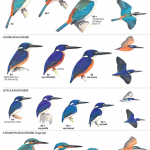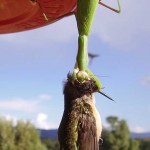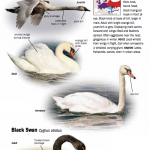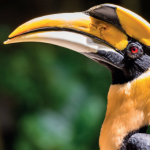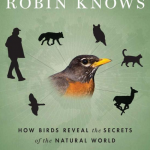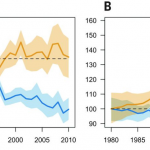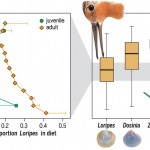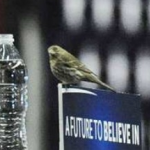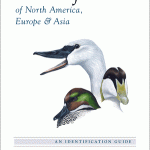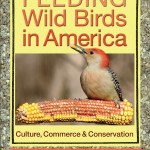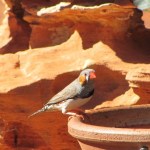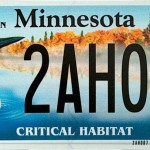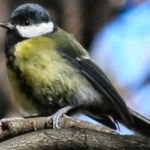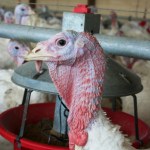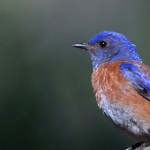Aves (birds)
There are close to just under 900 species of bird in Australia, and The Australian Bird Guide by Peter Menkhorst, Danny Rogers, Rohan Clarke, Jeff Davies, Peter Marsack, and Kim Franklin covers just over 900 of them. Where do the extras come from? Sea birds in the nearby oceans, I think.
This is an excellent bird book that all Australian birders simply need to have. Holiday season is just around the corner. Get one of these for your favoriate Australian!
This is not exactly a pocket guide. It is more of a car guide, and you better have a big glove box. The 6.8 x 9.7 inch format is hefty…
Giant insects can eat tiny dinosaurs.
In this case, the giant insects are praying mantis, and the dinosaurs are hummingbirds and other small birds. In some cases, maybe most cases, this involves small birds like hummingbirds being taken at nectar sites (natural or otherwise) by introduced species of praying mantis in the US.
Here's the info from the recently published paper:
Bird Predation By Praying Mantises: A Global Perspective, by Martin Nyffeler, Michael R. Maxwell, and J. V. Remsen, Jr.
ABSTRACT
We review 147 incidents of the capture of small birds by mantids (order Mantodea, family…
Just got my copy of Birds of Europe, North Africa, and the Middle East: A Photographic Guide by Frédéric Jiguet and Aurélien Audevard.
This is the first and only field-ready photographic bird guide that covers every species in Europe. There are 2,200 photos covering 860 species. The West Asian and North African coverage is of all of the species there that have occurred in Europe, so think of this primarily as a European guide.
The entry for the Mute Swan.
I hasten to add and emphasize. These are not your grandaddy's photographs. Many photographic guides have pretty nice looking…
What is sex?
Musings at 10,000 Birds:
This is a simple question with a complicated answer. Part of the answer is this: The biological identity of an individual that guides its choice of mate. So, in a simple version of the world of a bird, there are two sexes, male and female, and males chose females and females chose males as mates.
Assume for a moment that there is choice, and that the choice is based on a discernible feature. So, for example, males and females prefer to mate with a member of the opposite sex who has a blue and white pattern on its breast. So far so good, and so far simple…
This is just a pointer to my latest post at 10,000 birds on a tool using crow from Hawaii, as well as recent climate change related threats to the birds of that island state.
Crows are smart. Anyone who watches them for a while can figure this out.
But that is true of a lot of things. Your baby is smart (not really). Your dog is smart (not really). Ants are smart (sort of).
It takes a certain degree of objective research, as well as some serious philosophy of intelligence (to define what smart is) to really address this question. But when the research is done and the dust settles, crows are smart.
We were all amazed (or not, because we already knew that crows are smart) to find that New Caledonian crows made and used tools. Now, we know (see my most recent…
There was a dead rabbit in the middle of the road today. I suspected such a thing, nearby, just out of sight, and edible, because I noticed some crows taking off whenever a car went by. Then, when I went over, I could see the rabbit that they were feasting on between drive-bys.
I had been looking for rabbits lately, because of this: the cat had switched to hanging out by the upstairs window, the better to observe the just arriving Juncos (snow birds, it is fall). She had previously spent most of her time observing rabbits from the lower, ground level windows, until just the other day when…
I've got a new post up at 10,000 Birds on a study looking at changing populations of several hundred common species of birds in Europe and North America (mainly the US).
The two subcontinents exhibit dramatically different patterns, as shown in the enigmatic graph above.
Go to the post to unravel this intriguing mystery!
You've heard the phrase, "Nothing in biology makes sense except in the light of evolution," an insightful phrase penned in 1972 by Theodosius Dobzhansky. I would like to add a second part to that phrase, and it goes like this: "... and, nothing in evolution makes sense except in the light of co-evolution." This would hardly be an exaggeration, and it can hardly be better exemplified than with examples from migratory birds. Migratory birds have to be adapted to at least three different ecological settings. They breed in one area, migrate (and often spend considerable time) through another…
You all know this happened.
But there is some controversy over what kind of bird it is.
There is no doubt whatsoever that the bird was a finch. However, what kind? Most likely a house finch, because they are common, and the most likely to live in a big auditorium thingie and not be fearful of people.
A pic of the bird is above. Here is another:
What do you think it is?
There are three kinds of books that count as animal (usually bird) guides.
1) A pocket field guide of the critters of a reasonably circumscribed geographical area, like the Peterson Field Guide to Birds of Eastern and Central North America. This is a small book that can fit in a big pocket, and a classic guide like this one is something you'll want to have with you while bird watching in the eastern or central US.
2) A big book, not suitable for pockets, of the critters of a reasonably circumscribed geographical area. A great example of this is The Crossley ID Guide: Eastern Birds . It…
When the Texas A&M University Press asked me to consider reviewing Feeding Wild Birds in America: Culture, Commerce, and Conservation by Paul Baicich, Margaret Barker, and Carrol Henderson, I had mixed feelings.
Was this just another backyard bird feeding guide? That would be nice, but not too exciting. After all, feeding birds is just a matter of getting a bird feeder and keeping it full, right? Was it an indictment of what some might consider a bad practice, because it brings birds in close contact with killer windows and cats, and causes them to become dependent on fickle human…
We often hope, even assume, that technology will fix our problems. We also know that sometimes technology creates a problem. In this case, technology can help us fix the problem of needing to keep the fossil carbon in the ground by making use of the sun, but created the problem of vaporizing birds with intensely focused solar energy. But then, the engineers applied adjustment to the technology to save the birds!
I wrote it up here on 10,000 Birds, where I write a monthly installment on birds and stuff: Solar Plant Stopped Killing Birds: One Weird Trick!
Changes in the daily variability of high and low temperatures in certain regions may stress wild bird populations. A new study of semi-wildish Zebra Finches demonstrates this. I have a post on the research here, at 10,000 birds. Have a look!
Check out my latest contribution to the bird blog 10,000 birds:
Faithful Loons and Human Lunacy
Every year there manage to be two Loons out in front of the cabin, up in Minnesota’s lake country. They nest on the same, ever-expanding semi-floating but occasionally shrinking nest over behind the point, so we can’t see the nest without going across the marsh in a canoe. It is a great place to nest, but for one small detail. Behind the embayment formed by the point is a tall bluff, the edge of an ancient river valley that passed through the area during one or more (probably a few) prior…
People were fascinated, excited, and some were enraged, by this awareness raising campaign of BirdLife South Africa.
I might have preferred this modification:
When I studied the Efe Pygmies of the Congo, I discovered (and yes, it was me who discovered this amazing fact everyone now knows) that the Efe organize their space in elongated linear trails. They knew all about everything along those specific trails, and their knowledge of other trails was often very limited. If an Efe person spent time living with a group associated with a trail, he* would learn about that trail as well. Most interesting is that one’s knowledge of important things like where to find food (or danger) was based on experience not on general principles. So an Efe off his trail…
Unless you are living in a chicken coop, you have probably heard about the Turkey Crisis in Minnesota and surrounding upper plains/midwestern states. Every few days we hear more news: Millions of farmed turkeys are being put down in one turkey farm after another, because the farm's turkeys are infested with the H5N2 bird flu.
I should say right away, that according to the Minnesota Turkey Growers Association, there is no significant risk of a turkey shortage. While it is always bad to count your chickens before they hatch, apparently this is not a big problem with the larger fowl.
See also…
This is one of those great examples of research you can probably use in an advanced biology classroom (high school) or intro college bio pretty effectively. It includes birds. It includes hormones. It includes evolution. What else is there, really?
I did a very brief writeup on it here, and you can get the original paper which is very straight forward and readable.
The bottom line: Females in one species of bird manage to figure out that under certain, occasional conditions if they produce really obnoxious and overbearing sons, those sons will do well. So they do. There is a phylogenetic…
